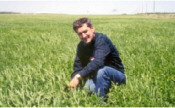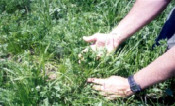



Grazing Studies Yield Recipes To Beat Bluegrass, Slash Feedlot Expenses
By Canada's Agricultural Producers Addressing Environmental Issues, Meristem Life And Science, Beef Science. Two efforts supported by CAPAEI deliver unique strategies to benefit the land base and boost production success for both cow-calf producers and feedlot operators.New grazing research has yielded innovative strategies to help both cow-calf producers and feedlot operators strengthen their land base and their pocketbooks.
The research was conducted in two separate efforts by Agriculture and Agri-Food Canada's (AAFC) Lacombe Research Centre, with funding support for the information analysis components provided by Canada's Agricultural Producers Addressing Environmental Issues (CAPAEI).
In the first effort, researchers examined new approaches for sod seeding alfalfa to rejuvenate old pastures. This resulted in a method based on using an aerator unit plus glyphosate-based herbicide that allows alfalfa to beat out competition from bluegrass.
"Over the years, we've done a lot of work trying to rejuvenate pastures by getting more alfalfa into them," says forage / beef specialist Duane McCartney of Western Forage Beef Group of the Lacombe Research Centre. "The big problem for sod seeding in Western Canada, as opposed to the Southern U.S. or Eastern Canada, is the competition from other plants, specifically bluegrass. But we developed a method around using a new type of aerator unit that can help producers overcome this hurdle. There are thousands of acres of depleted pasture in Western Canada that could benefit from this approach." 
In the second effort, the researchers investigated the potential for feedlot operators to place incoming calves into a grazing system with Italian ryegrass, as an expense saving and land benefiting alternative to putting the animals straight into the feedlot.
"We found this is a way that calves can be accustomed to coming off an auction or weaning scenario and placed into a grazing situation rather than placed immediately into the congestion of the feedlot," says McCartney. "The results included cost savings from fewer days in the feedlot, a major reduction in health issues, as well as the inherent benefits to the land of growing more forage."
The battle with bluegrass
The progress on sod seeding alfalfa was the result of a long-term effort aimed specifically at benefiting cow-calf producers in Western Canada, says McCartney.
 Cow-calf producers in regions with more reliable moisture and less plant competition typically have success broadcasting alfalfa seed onto the pasture and using cows to trample it for good soil contact. "With good rainfall, alfalfa will establish under those conditions," says McCartney. "Often, frost seeding works too."
Cow-calf producers in regions with more reliable moisture and less plant competition typically have success broadcasting alfalfa seed onto the pasture and using cows to trample it for good soil contact. "With good rainfall, alfalfa will establish under those conditions," says McCartney. "Often, frost seeding works too."
In Western Canada, bluegrass outcompetes alfalfa seeded with this method, but through a process of trial and error the researchers successfully identified a practical strategy to alter the competitive balance more in favor of alfalfa establishment.
"In our early work, we developed some sod seeding drills that would help increase alfalfa's competitiveness, but with the small market for this in North America there wasn't enough incentive for this type of drill to be manufactured, so we turned instead to evaluating equipment that was already available," says McCartney.
The researchers examined a variety of drills that showed potential for working in a pasture situation, including a number of European and Australian drills. However, in the process, they found that a different type of tool ultimately showed greater promise. This tool was an aerator type unit called "AerWay,"manufactured by Holland Hitch of Norwich, Ont.
"The AerWay unit is basically a rotovator and aerator rolled into one that operates like a rotary harrow," says McCartney. "There are a number of models of this type of unit now developed by different manufacturers that machinery dealers in Western Canada have available to rent for a variety of cultivation uses."
Aerator-type unit a valuable tool
In the U.S., AerWay-style units are now also used extensively in the cotton and corn industries, with some units as large as 16 feet wide. "Theses units look like a gigantic version of what golf courses use for aerating their greens," says McCartney. "The model we focused on had 'v'-shaped spikes that were eight to 10 inches long and rotated on a cylinder."
The researchers developed a system using the Aerway unit, whereby alfalfa seed is broadcast on the ground, then run over by the unit to provide a good level of soil disturbance and covering the seed to promote growth, without breaking the seed. Two to three passes were typically needed to get the best results.
"On an old depleted pasture that was heavily infested with bluegrass, this method wouldn't work because the bluegrass took over," says McCartney. "But in an area where when you looked down to the ground you could see some soil, it would work. We also tried this approach with other forage species and it didn't work, but it worked well with alfalfa."
In regional trials, the method was successful at sites in Saskatchewan and Alberta. Manitoba sites also had success, but required greater support through other management approaches.
"In the Manitoba work, we found that if we treated the area with herbicide to cut back on the existing vegetation, we got better success. And if we added some phosphorous at the time of seeding, we got even better success."
Controlling vegetation key
 Based on the research findings, the researchers recommend producers graze their area right down to the ground before going to seed. "Producers could do it for either fall seeding or spring seeding," says McCartney. "After the area is seeded, we'd also recommend producers turn the cows out on that area to trample the seed a bit.
Based on the research findings, the researchers recommend producers graze their area right down to the ground before going to seed. "Producers could do it for either fall seeding or spring seeding," says McCartney. "After the area is seeded, we'd also recommend producers turn the cows out on that area to trample the seed a bit.
"The recipe boils down to: graze to the ground, use a bit of herbicide as needed, use some phosphorous and seed heavy with alfalfa – at a rate using about three pounds."
The key is to control the existing vegetation, says McCartney. "You can either do that with the herbicide or graze it really heavy in the fall and then after you seed it, run it over with the cows to trample it. From time to time, you may need to keep the existing grass back by grazing it. So in other words you may need two or three quick grazes that following year."
The researchers were initially concerned about having cows graze in the first year, he says. "We thought the hoof action would trample the little alfalfa plants or the cows would chew them up or pull them up. But that wasn't the case, and the cows are able to graze just enough to keep the grass back and prevent the competition."
Italian ryegrass: backgrounding alternative
In the second research effort, focused on the potential of grazing Italian ryegrass during the early backgrounding stages, McCartney and colleagues drew on a concept established with winter wheat fields in key cattle production areas of the U.S.
"We got the idea from the success producers in Kansas, Oklahoma and Texas were having with integrated grazing systems using winter wheat," says McCartney. "These producers would allow cattle to graze in the winter wheat fields in the fall and the winter time, and then pull them in early March to allow the winter wheat to grow. We had done of lot of work looking at Italian ryegrass, and felt it had excellent potential since it could produce more biomass than any other crop we could use in this type of system."
Italian ryegrass is an annual that won't overwinter in Western Canada. "You don't have to worry about volunteers with Italian ryegrass," says McCartney. "It's important to make sure to use the Italian ryegrass crop type, not the westerwold ryegrass type, because the westerwold type will set seed and result in volunteers the next year."
Strong gains, no health issues
In an on-farm trial central to the research, McCartney and colleagues partnered with a large backgrounding operation near Melfort, Sask. "This was an operation that traditionally brought in semi trailers of cattle from the auction marts and backgrounded them in its feedlot. In our trial, we put half the animals into the normal feedlot process, but the other half we separated into a grazing regime with Italian ryegrass."
The Italian ryegrass crop was produced specifically for fall grazing, under an approach designed to maximize biomass. "We grew the Italian ryegrass along with the silage crop," says McCartney. "Once the main crop was cut for silage, the Italian ryegrass grew in the fall and we were able to put a group of the calves straight from the auction mart on to the field."
Calves were introduced at high stocking rates that were supported by the high biomass of the Italian ryegrass. The animals gained one-and-a-half to two pounds per day and were able to sustain the regime and the results until mid November. "In a second trial conducted later at Lacombe, we were able to keep the calves out until mid December," notes McCartney. "In both trials, we did graze in snow, and we didn't have any health problems. By comparison, in the Saskatchewan trial alone we had 25 major cases of pneumonia for the cattle in the feedlot area."
The encouraging results under the Italian ryegrass grazing approach make it a valuable option for feedlot operations, says McCartney. "The cost savings and land benefits make this system definitely worth looking at."
Watch for more information
Final analysis and information on both the alfalfa and Italian ryegrass strategies is under completion and will be available in the coming months at www.foragebeef.ca and through other outlets.
Canada's Agricultural Producers Addressing Environmental Issues (CAPAEI) is a federal initiative funded through AAFC's Greencover Canada program. It is designed by, and administered through the Soil Conservation Council of Canada. The Canadian Cattlemen's Association coordinates the delivery of the program to beef cattle producers.


